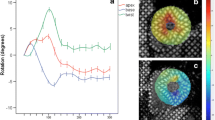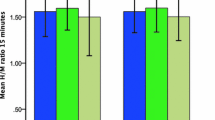Abstract
Purpose
High intensity systematic physical training leads to myocardial morphophysiological adaptations. The goal of this study was to investigate if differences in training were correlated with differences in cardiac sympathetic activity.
Methods
58 males (19-47 years), were divided into three groups: strength group (SG), (20 bodybuilders), endurance group (EG), (20 endurance athletes), and a control group (CG) comprising 18 healthy non-athletes. Cardiac sympathetic innervation was assessed by planar myocardial 123I-metaiodobenzylguanidine scintigraphy using the early and late heart to mediastinal (H/M) ratio, and washout rate (WR).
Results
Left ventricular mass index was significantly higher both in SG (P < .001) and EG (P = .001) compared to CG without a statistical significant difference between SG and EG (P = .417). The relative wall thickness was significantly higher in SG compared to CG (P < .001). Both left ventricular ejection fraction and the peak filling rate showed no significant difference between the groups. Resting heart rate was significantly lower in EG compared to CG (P = .006) and SG (P = .002). The late H/M ratio in CG was significantly higher compared to the late H/M for SG (P = .003) and EG (P = .004). However, WR showed no difference between the groups. There was no significant correlation between the parameters of myocardial sympathetic innervation and parameters of left ventricular function.
Conclusions
Strength training resulted in a significant increase in cardiac dimensions. Both strength and endurance training seem to cause a reduction in myocardial sympathetic drive. However, myocardial morphological and functional adaptations to training were not correlated with myocardial sympathetic activity.



Similar content being viewed by others
References
Strauss HC, Bigger JT, Saroff AL, Giardina EG. Electrophysiologic evaluation of sinus node function in patients with sinus node dysfunction. Circulation 1976;53:763-76.
Brandao MU, Wajngarten M, Rondon E, Giorgi MC, Hironaka F, Negrao CE. Left ventricular function during dynamic exercise in untrained and moderately trained subjects. J Appl Physiol 1993;75:1989-95.
D’Andrea A, Caso P, Severino S, Galderisi M, Sarubbi B, Limongelli G, et al. Effects of different training protocols on left ventricular myocardial function in competitive athletes: A Doppler tissue imaging study. Ital Heart J 2002;3:34-40.
Menapace FJ, Hammer WJ, Ritzer TF, Kessler KM, Warner HF, Spann JF, et al. Left ventricular size in competitive weight lifters: An echocardiographic study. Med Sci Sports Exerc 1982;14:72-5.
Pelliccia A, Maron BJ, Spataro A, Proschan MA, Spirito P. The upper limit of physiologic cardiac hypertrophy in highly trained elite athletes. N Engl J Med 1991;324:295-301.
Pluim BM, Zwinderman AH, van der Laarse A, van der Wall EE. The athlete’s heart. A meta-analysis of cardiac structure and function. Circulation 2000;101:336-44.
Spirito P, Pelliccia A, Proschan MA, Granata M, Spataro A, Bellone P, et al. Morphology of the “athlete’s heart” assessed by echocardiography in 947 elite athletes representing 27 sports. Am J Cardiol 1994;74:802-6.
Chapman JH. Profound sinus bradycardia in the athletic heart syndrome. J Sports Med Phys Fitness 1982;22:45-8.
Matsuo S, Nakamura Y, Takahashi M, Matsui T, Kusukawa J, Yoshida S, et al. Cardiac sympathetic dysfunction in an athlete’s heart detected by 123I-metaiodobenzylguanidine scintigraphy. Jpn Circ J 2001;65:371-4.
Estorch M, Serra-Grima R, Flotats A, Mari C, Berna L, Catafau A, et al. Myocardial sympathetic innervation in the athlete’s sinus bradycardia: Is there selective inferior myocardial wall denervation? J Nucl Cardiol 2000;7:354-8.
Lang RM, Bierig M, Devereux RB, Flachskampf FA, Foster E, Pellikka PA, et al. Recommendations for chamber quantification: A report from the American Society of Echocardiography’s Guidelines and Standards Committee and the Chamber Quantification Writing Group, developed in conjunction with the European Association of Echocardiography, a branch of the European Society of Cardiology. J Am Soc Echocardiogr 2005;18:1440-63.
Sahn DJ, DeMaria A, Kisslo J, Weyman A. Recommendations regarding quantitation in M-mode echocardiography: Results of a survey of echocardiographic measurements. Circulation 1978;58:1072-83.
Schiller NB, Shah PM, Crawford M, DeMaria A, Devereux R, Feigenbaum H, et al. Recommendations for quantitation of the left ventricle by two-dimensional echocardiography. American Society of Echocardiography Committee on Standards, Subcommittee on Quantitation of Two-Dimensional Echocardiograms. J Am Soc Echocardiogr 1989;2:358-67.
Gardin JM, Adams DB, Douglas PS, Feigenbaum H, Forst DH, Fraser AG, et al. Recommendations for a standardized report for adult transthoracic echocardiography: A report from the American Society of Echocardiography’s Nomenclature and Standards Committee and Task Force for a Standardized Echocardiography Report. J Am Soc Echocardiogr 2002;15:275-90.
Devereux RB, Alonso DR, Lutas EM, Gottlieb GJ, Campo E, Sachs I, et al. Echocardiographic assessment of left ventricular hypertrophy: Comparison to necropsy findings. Am J Cardiol 1986;57:450-8.
Corbett JR, Akinboboye OO, Bacharach SL, Borer JS, Botvinick EH, DePuey EG, et al. Equilibrium radionuclide angiocardiography. J Nucl Cardiol 2006;13:e56-79.
Thom A, Smanio P, editors. Medicina Nuclear em Cardiologia - da Metodologia à Clínica. São Paulo: Atheneu; 2007. p. 176-9.
Flotats A, Carrio I, Agostini D, Le Guludec D, Marcassa C, Schaffers M, et al. Proposal for standardization of 123I-metaiodobenzylguanidine (MIBG) cardiac sympathetic imaging by the EANM Cardiovascular Committee and the European Council of Nuclear Cardiology. Eur J Nucl Med Mol Imaging 2010;37:1802-12.
Chirumamilla A, Travin MI. Cardiac applications of 123I-mIBG imaging. Semin Nucl Med 2011;41:374-87.
Fagard RH. Athlete’s heart: A meta-analysis of the echocardiographic experience. Int J Sports Med 1996;17:S140-4.
Koyama K, Inoue T, Hasegawa A, Oriuchi N, Okamoto E, Tomaru Y, et al. Alternating myocardial sympathetic neural function of athlete’s heart in professional cycle racers examined with iodine-123-MIBG myocardial scintigraphy. Ann Nucl Med 2001;15:307-12.
Dae MW, O’Connell JW, Botvinick EH, Ahearn T, Yee E, Huberty JP, et al. Scintigraphic assessment of regional cardiac adrenergic innervation. Circulation 1989;79:634-44.
Carrio I, Cowie MR, Yamazaki J, Udelson J, Camici PG. Cardiac sympathetic imaging with mIBG in heart failure. JACC Cardiovasc Imaging 2010;3:92-100.
Somsen GA, Verberne HJ, Fleury E, Righetti A. Normal values and within-subject variability of cardiac I-123 MIBG scintigraphy in healthy individuals: Implications for clinical studies. J Nucl Cardiol 2004;11:126-33.
Morozumi T, Kusuoka H, Fukuchi K, Tani A, Uehara T, Matsuda S, et al. Myocardial iodine-123-metaiodobenzylguanidine images and autonomic nerve activity in normal subjects. J Nucl Med 1997;38:49-52.
Tsuchimochi S, Tamaki N, Tadamura E, Kawamoto M, Fujita T, Yonekura Y, et al. Age and gender differences in normal myocardial adrenergic neuronal function evaluated by iodine-123-MIBG imaging. J Nucl Med 1995;36:969-74.
Disclosure
None.
Conflict of interest
The authors declare that they have no conflict of interest.
Author information
Authors and Affiliations
Corresponding authors
Rights and permissions
About this article
Cite this article
Miranda, D.P., dos Santos, M.J., Salemi, V.M.C. et al. Differential effects of variation in athletes training on myocardial morphophysiological adaptation in men: Focus on 123I-MIBG assessed myocardial sympathetic activity. J. Nucl. Cardiol. 21, 570–577 (2014). https://doi.org/10.1007/s12350-014-9876-6
Received:
Accepted:
Published:
Issue Date:
DOI: https://doi.org/10.1007/s12350-014-9876-6




